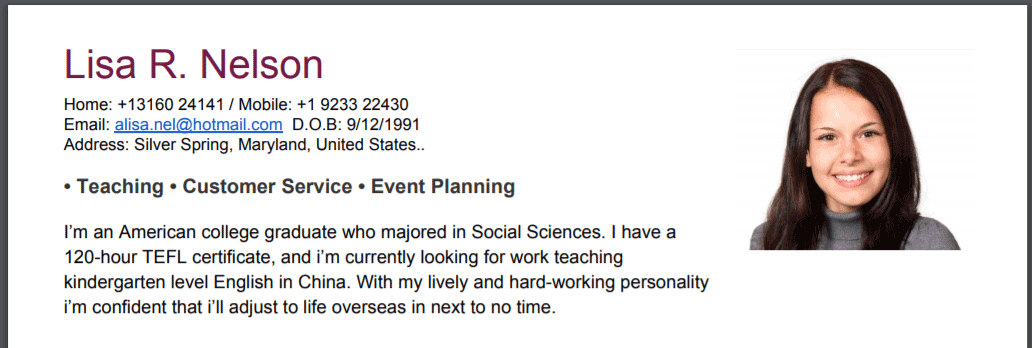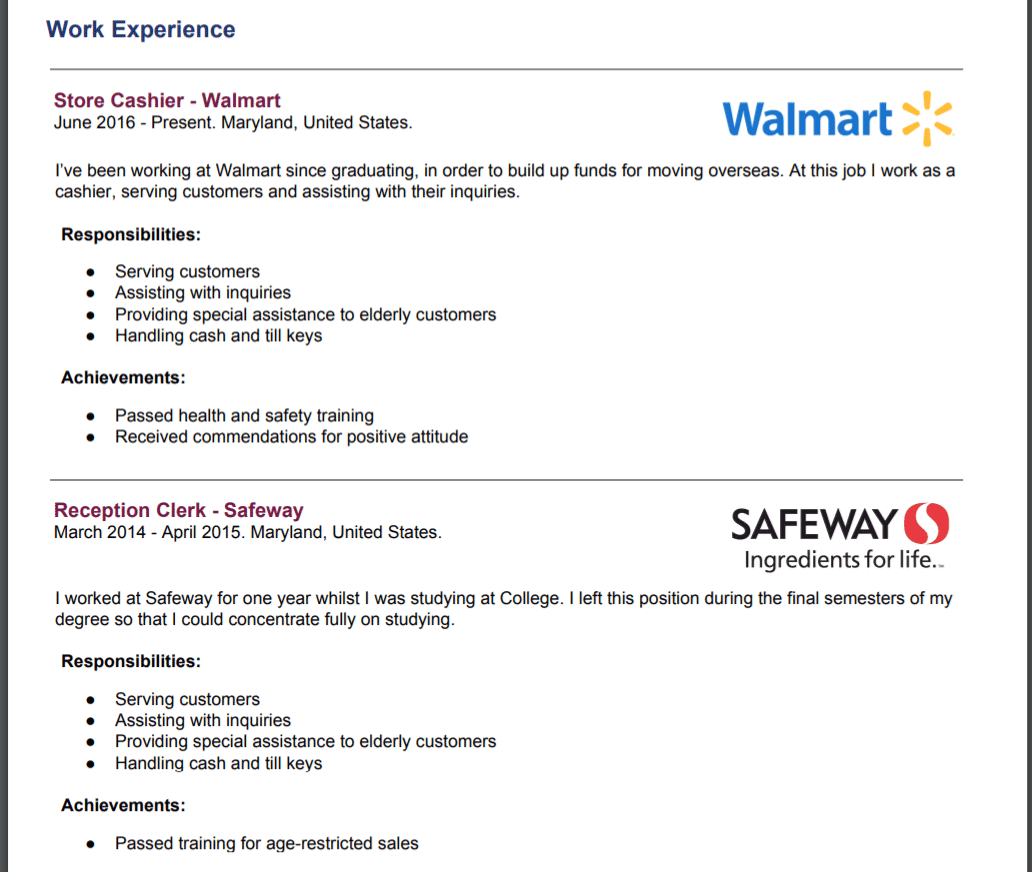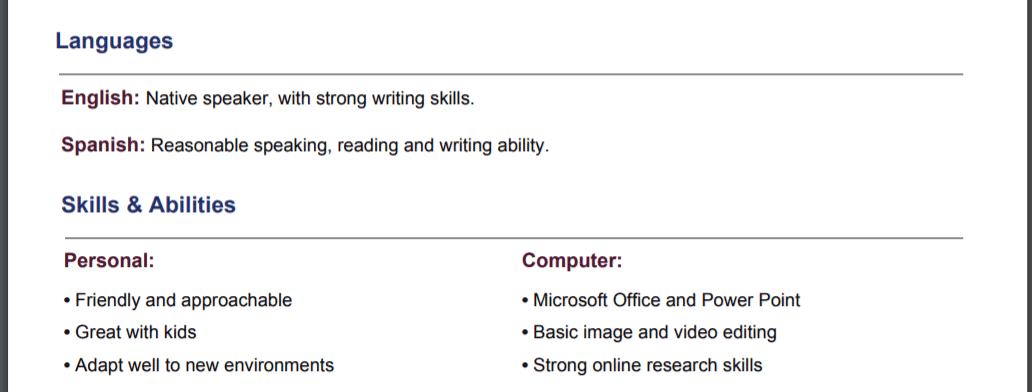Preview
We’re now going to take a look at the different sections of our CV template, and run through how you can start to customize it. While you might choose not to use this template yourself, there will still be some useful information here which might be handy for you in the future.

Introduction:
This opening section starts by laying out your personal details – who you are, and what you’re all about. It’s important to include a friendly, forward-facing photograph when applying for TEFL positions so that schools can begin to feel your personality coming through. If you don’t have one, then go take one! Just find a white wall with bright lighting and get a friend or family member to take 20 photos, then pick the best one.
Aside from the photograph, it’s also important to include contact information and a short bio. As an added punch, it can be good to throw some bullet points in here at the top. Recruiters may go through 30 or more resumes per day, and small things like this can help to create a stronger impression.

Work experience:
If you’re entirely new to teaching, then filling out your work experience could be a little tricky – however with a few tips you can still steer this section in the right direction.
To start with, if you don’t have any previous teaching experience, then we’d advise keeping this section relatively brief, so that you can maximize your impact in other areas. Think carefully about any roles you’ve had in the past, then put the most relevant and longest-lasting ones into this section. For ESL recruiters, length of employment is more important than the number of jobs you’ve had, as they’ll need you to last your contract length or longer.
When listing your previous jobs, be sure to draw attention to any transferable skills that might be useful for your new career as a teacher. Some examples of these transferable skills are as follows:
- Leadership skills. If you led a group on a project this will show employers that you have the skills to control and lead a class.
- Public speaking skills. This is an obvious one. If you have ever given reports or presented your work in front of a group, make sure to highlight this.
- Communication skills. As a teacher, you have to interact with students, other teachers, parents and teaching assistants. Use your work experience to prove you have the skills to do this well.
- Problem-solving skills. This is a more abstract skill. You will need such skills to deal with problematic students, demanding parents and your own classes. If you can use your past work experience to show that you know how to identify and solve problems, it will look really impressive to your potential employer.
Note: With our template, we’ve included company logos. These aren’t necessary, but if you are able to neatly place a logo here it can help to stand out from the crowd, and also show that you’re proud of where you’ve worked before. If you can’t neatly place a logo there, don’t worry – just leave it out.

Education:
When it comes to filling out your educational background, be sure to start with your largest achievements. If you have a degree, then you would want to mention that first. Include all the relevant information such as the university name, course dates, degree title etc. As with the work experience section above, it doesn’t hurt to add a tasteful logo from your university if you’re able to do so.
You can also add your high school and any other institutes you’ve studied at. If you don’t have a degree then these will be of more importance to you.
As a side note, it can also be useful here to mention the countries of these institutes, as many schools are interested in hiring teachers with certain backgrounds. If you’ve studied in a native-Engish speaking country, be sure to add this information here. Similarly, if you’ve studied in the country which you’re applying to work in, this could also be worth drawing attention to, as it will show you have some familiarity with the education system there.

Awards & Certifications:
Here you can show off your new TEFL certificate. As part of this, you can mention what you’ve covered in this course and what you’re now able to do. If your resume is lacking information in other areas – such as with work experience and education, then you might wish to expand on this section further – perhaps by listing out key modules and the specific skills you’ve learned.
If you have any other awards, qualifications, certifications or scholarships then add them in here to show how hard-working you are.

Languages, Skills & Abilities:
These sections are useful for adding some extra bites of information. If you have some other language abilities, then be sure to mention that – it can show you have some experience with language learning.
You could also mention your personal traits and other skills. These aren’t too crucial, but can be good to include especially if you have some hidden talents up your sleeve – sketching, arts & crafts, acting etc.

Comments:
This final section brings your resume to a close. You should be brief with mentioning what you’re looking for, include a short summary of who you are, where you are, and when you’re looking to start employment. If you’re applying for a particular job advert which you’ve seen online, then be sure to modify this section to target that advert. If the position is for young learners – then mention that’s what you’re looking for.
With your final line it’s always good to leave things open for conversation. We’d recommend leaving your email here rather than telephone number – recruiters will usually be located in the countries which you’re applying to go and teach in, so they’ll often prefer to email you as the first point of contact.
Optional extras:
If you’re looking to pad out your resume a little further, you could add some of these extra fields to it. However, if you’ve already filled up two pages of content so far, it might be worth leaving things as they are.
Activities and Hobbies
Listing these can add to your potential employer’s understanding of who you are. If you have hobbies or pastimes that could benefit your teaching practice, or your ability to adjust to a new country, you could add them here. Some great hobbies include:
- Language learning
- Volunteer positions
- Travel, particularly if you go overseas for long periods.
References
This section is not strictly necessary on your CV. However, you may need some references at some point during the job application process. If you don’t put them on your CV, make sure you’ve already worked out who will give you a glowing reference, and ask their permission to give their contact details to potential employers. Previous teachers, lecturers, and employers are good paths to go down when thinking of references.

 Rated 97% on GoOverseas!
Rated 97% on GoOverseas!